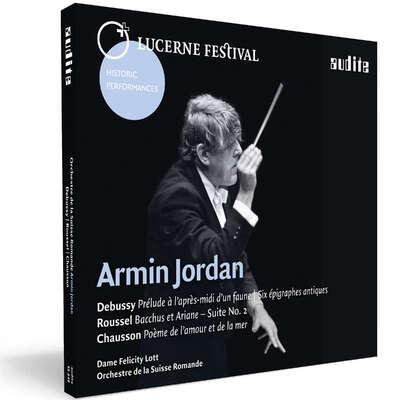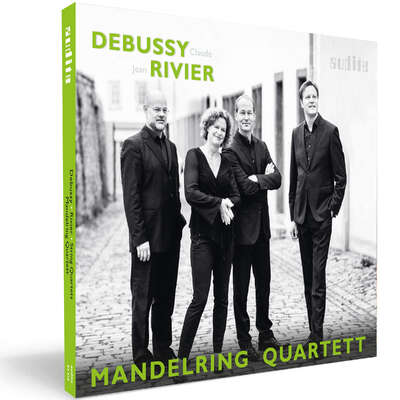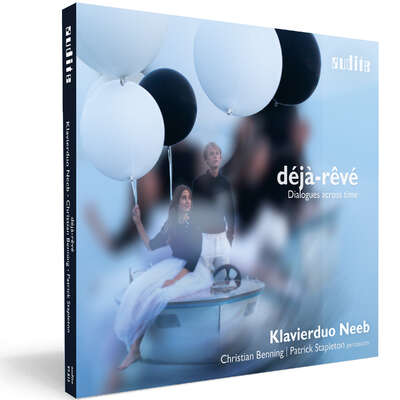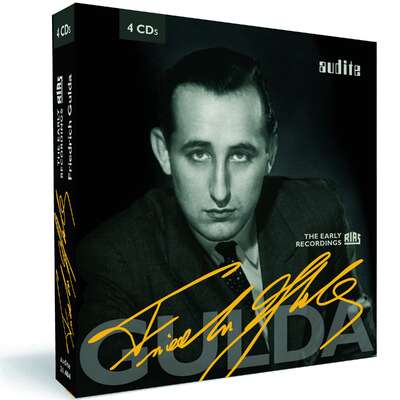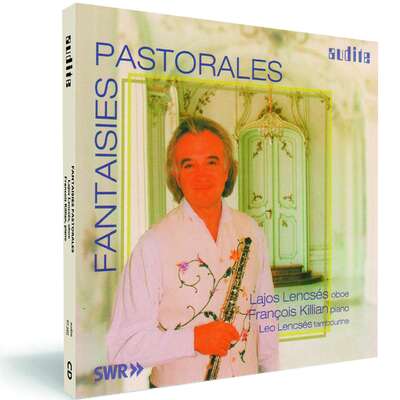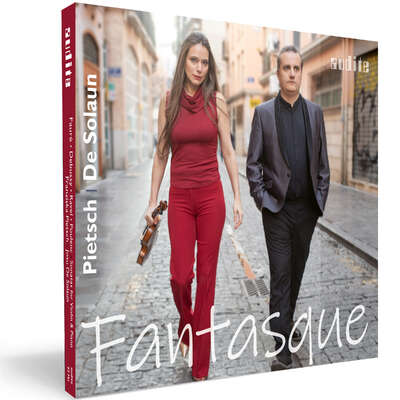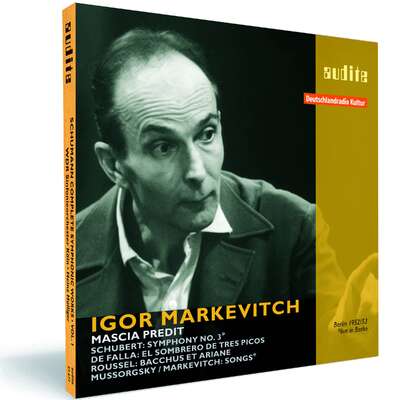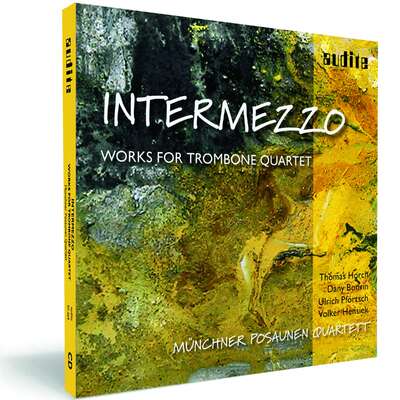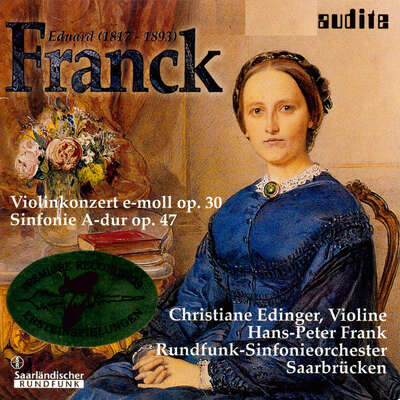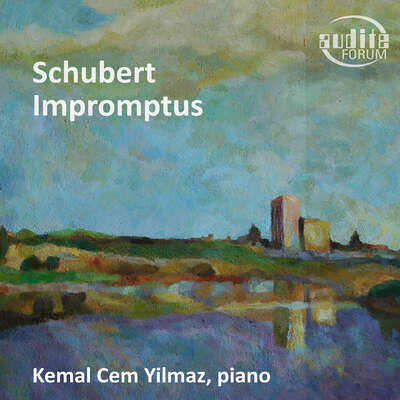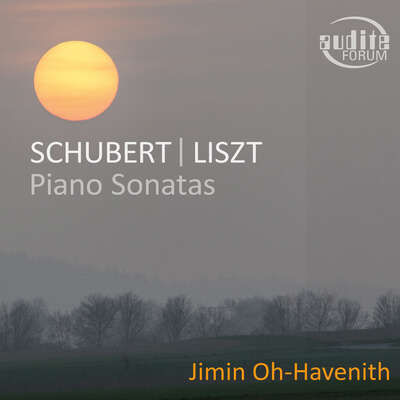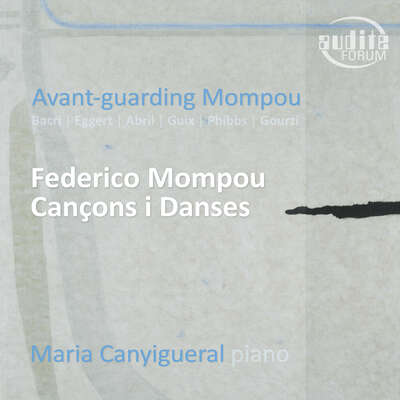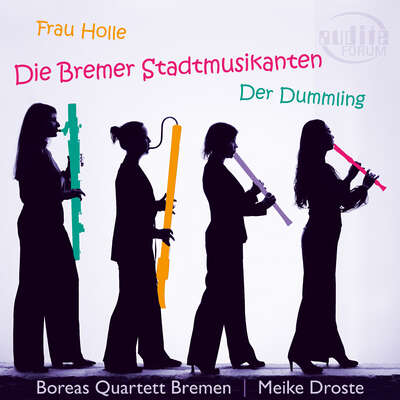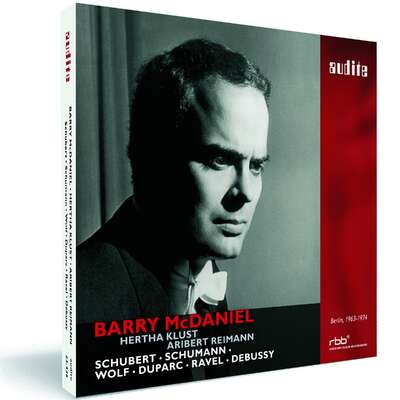
Auto-Rip
The performances of the Swiss conductor Armin Jordan are characterised by a soft, supple and richly colourful orchestral sound, flexibility and warmth. He was a master of French repertoire as well as the music tradition of Central Europe, combining both traditions in his very own musical thumbprint. Released here for the first time are live recordings made in Lucerne with the Orchestre de la Suisse Romande, which experienced a golden era under Jordan’s leadership between 1985 and 1997.more
"In the opulent playing of the Orchestre de la Suisse Romande, Jordan succeeds in achieving an ideal balance between orchestral virtuosity, sharp rhythms and subtle harmonies." (Pizzicato)
Details
|
Armin Jordan conducts Debussy, Roussel & Chausson
LUCERNE FESTIVAL Historic Performances, Vol. 15 |
|
| article number: | 95.648 |
|---|---|
| EAN barcode: | 4022143956484 |
| price group: | BCB |
| release date: | 4. September 2020 |
| total time: | 74 min. |
Bonus Material
- Digibooklet Armin Jordan
-
Producer's comment
First-hand impressions of producer Ludger Böckenhoff [German]
Informationen
He switched effortlessly between different musical spheres: the Swiss conductor Armin Jordan, who died in 2006, was a master of French repertoire as well as the musical tradition of Central Europe, combining both traditions in his very own musical thumbprint. Jordan's performances are characterised by a soft, supple and richly colourful orchestral sound, flexibility and warmth.
Released here for the first time are live recordings of his two only performances at LUCERNE FESTIVAL, given in 1988 and 1994 conducting the Orchestre de la Suisse Romande, which experienced a golden era under Jordan's leadership between 1985 and 1997.
This CD comprises Armin Jordan's "specials", such as Debussy's Prélude à l'après-midi d'un faune or the Six épigraphes antiques in orchestrations by Ansermet. In Chausson's Poème de l'amour et de la mer we meet Jordan the opera conductor, treasuring the fantastic Felicity Lott: here, the emotional component of the performance appears more intense than in the studio recording of 2001. In the second suite from Roussel's ballet Bacchus et Ariane Jordan also creates a thrilling sense of drama. He never had the opportunity to record this rarely performed piece in the studio: this live recording from Lucerne therefore fills a gap in his discography.
The 28-page booklet in three languages contains a portrait of the conductor by Peter Hagmann and features photos from the festival archive, published here for the first time.
In cooperation with audite, LUCERNE FESTIVAL presents the "Historic Performances" series featuring outstanding concert recordings of artists who have shaped the festival throughout its history. The aim of this CD edition is to rediscover treasures - most of which have not previously been released - from the first six decades of the festival, which was founded in 1938 with a special gala concert conducted by Arturo Toscanini. These recordings have been made available by the archives of SRF Swiss Radio and Television, which has broadcast the Lucerne concerts from the outset. Painstakingly re-mastered and supplemented with photos and materials from the LUCERNE FESTIVAL archive, they represent a sonic history of the festival.
Reviews
www.on-mag.fr | 15 mai 2023 | Jean-Pierre Robert | May 15, 2023 | source: https://on-mag.f... Armin Jordan au Festival de Lucerne
Son expérience du théâtre lyrique, de Wagner en particulier, a contribué à forger un style de direction d'une intensité rayonnante alliée à une précision tout en souplesse. Laissant à ses musiciens une grande latitude pour dessiner des contours chaleureux sans verser dans une accentuation anguleuse.Mehr lesen
https://hdmusic.me | JULY 21, 2021 | François Hudry | July 21, 2021 | source: https://hdmusic....
Here we find his stunning sense of colour and unique mix of fluidity, transparence and vigour which he made his own.Mehr lesen
lexnews.free.fr | Édition Semaine n° 5 / Février 2021 | Philippe-Emmanuel Krautter | February 1, 2021 | source: http://www.lexne...
Ces archives ne pourront que réjouir le mélomane dès les premiers accords du fameux « Prélude à l’après-midi d’un faune » de Claude Debussy, cette œuvre qui sous la baguette du talentueux chef suisse déploie toutes ses couleurs chatoyantes. Mehr lesen
Diapason | N° 697 - Février 2021 | François Laurent | February 1, 2021
En concert au Festival de Lucerne, Armin Jordan dirige « son » Orchestre de la Suisse romande (il en fut le directeur musical entre 1985 et 1997),Mehr lesen
Le reste, hélas, n'est pas de la même eau. Le Prélude à l'après-midi d'un faune capté le 27 août 1988 accuse une certaine nonchalance jusque dans le fini instrumental, avec des cordes joliment frissonnantes mais des vents ternes voire approximatifs. Il y a plus de tenue en 1994 dans les Six épigraphes antiques orchestrées par Ansermet ; les atmosphères et la palette ont gagné en raffinement, malgré quelques baisses de tension (Pour un tombeau sans nom). Des deux partitions, le chef suisse laisse heureusement des gravures officielles abouties pour Erato, ce qui n'est pas le cas de la Suite n° 2 de Bacchus et Ariane, issue du concert de 1988 et jusque-là absente de sa discographie. Les relâchements dans l'exécution (l'« enchantement dionysiaque » est un peu mollasson) et la tendance de Jordan à arrondir les angles jusque dans la Bacchanale conclusive la signalent comme une curiosité. Un dernier regret : pourquoi avoir partout éradiqué les applaudissements du public?
AudioArt | 29.01.2021 | Liu Hansheng | January 29, 2021 | source: https://www.audi...
Chinesische Rezension siehe PDF!Mehr lesen
American Record Guide | January 2021 | Donald R Vroon | January 1, 2021
The Epigraphes are Debussy piano pieces orchestrated by Ernest Ansermet, who also recorded them (I have that recording). They have not been recordedMehr lesen
Scherzo | n° 368 - Dec 2020 | Santiago Martín Bermúdez | December 1, 2020
El sonido raras veces tendrá un nivel tan elevado como en este recital de Jordan en Lucerna, aunque es muy cierto que se trata de una obra muy tocada. Los Epígrafes, en orquestación de Ansermet, son como una hermosa propina. Y, para concluir, la prueba de bravura del recital, el Poème de Chausson con la voz poderosa, sugerente, de bellísimo timbre de Felicity Lott. 1994: el tiempo pasa, pero para registros así, conciertos como éste, el tiempo no pasa, o los mejora.Mehr lesen
www.artalinna.com | 5 NOVEMBER 2020 | Jean-Charles Hoffelé | November 5, 2020 | source: http://www.artal... Bacchus
Mais ailleurs la palette de couleurs des Genevois dore les fantaisies des Epigraphes antiques avec infiniment plus de poésie que ne le pouvaient leurs collègues bâlois, et déclenche dans le Poème de l’amour et de la mer tout un océan de sons et de sensationsMehr lesen
Fono Forum | November 2020 | Clemens Haustein | November 1, 2020
Nicht mehr allzu präsent ist der Name Armin Jordan fünfzehn Jahre nach seinem Tod. Diese Mitschnitte von Konzerten bei den Luzerner MusikfestwochenMehr lesen
Kapellmeisterliche Sorgfalt ging bei ihm einher mit wachem Sinn für Klangfarben, untrüglich war sein Gefühl für die innere Bewegungsrichtung einer Musik. Mit dem Orchestre de la Suisse Romande, dem er zwölf Jahre vorstand, gelangen in Luzern Auftritte von großer Klarheit und betörender Sonorität. Gleich Debussys "Prelude a l'apres-midi d'un faune" zu Beginn gerät zur Demonstration, was an Poesie allein schon aus dem exakten Timing erwachsen kann: das organische Beschleunigen und Bremsen der Bewegung, die genaue Vorbereitung und schließlich Bewältigung der Übergänge, von denen es zahlreiche gibt in diesem Stück. Die Musiker wiederum sind so beweglich und reaktionsschnell, weil sie keinen unnötigen klanglichen Ballast herumschleppen. Das schließt die Lust an klanglicher Größe nicht aus, wie sie gefordert ist bei zwei Stücken, die in hiesigen Konzertsälen kaum zu hören sind: Albert Roussels zweite Suite aus dem Ballett "Bacchus et Ariane", mit ihren überraschenden Klangmixturen und sicheren Pointen; und Ernest Chaussons "Poeme de l'amour et da la mer", ein duftig-geheimnisschwangeres Werk in "Tristan"- und "Parsifal"-Nachfolge. Felicity Lotts Sopran bewegt sich zwischen opernhafter Tragik und liedhafter Reflexion, Armin Jordan gibt den Klangbildern dieser Partitur Zeit zur Entfaltung und verliert sich doch nie in ihnen.
www.musicweb-international.com | Friday October 23rd | Stephen Francis Vasta | October 23, 2020 | source: http://www.music...
Armin Jordan can always be counted on for insightful, freshly considered performances, and these concert recordings from the Lucerne Festival prove noMehr lesen
In the mid-1950s, Ernest Ansermet, the Suisse Romande Orchestra's founder and longtime music director, made a cool, clear recording of the Faune that still remains sui generis. Jordan's approach is more Romantic: note the languorous, caressing flute and horn solos in the opening, and the various liquid woodwind interjections. An impulsive surge propels other passages, including the (in)famous nine-against-six; Jordan maintains clear textures in the fuller-sounding bits.
The Bacchus suite comes next - the headnote reflects organizational convenience rather than program order. It's a disappointment, which isn't entirely the conductor's fault. Roussel's style doesn't fit into the standard boxes: its harmonic idiom is extended French late-Romantic, yet his aesthetic is more angular, so much of his orchestral music leaves a vaguely sour impression. The juxtaposition throws Jordan slightly off his game. The mysterious opening and the driving, incisive final dance – akin to the Danse génèrale in Ravel's Daphnis – move with a firm sense of purpose; and the conductor brings a nice uplift to the rhythmically clearer passages. Some of the tuttis, on the other hand, come off as noisy and unorganized.
The Six épigraphes antiques, originally for piano duo, bring us back to Ansermet, who orchestrated them. The "open" soundscapes of the first two movements, with airy, vibrant violins, recall the composer's earlier writing, with the second introducing the more "advanced" harmonies of Jeux. The whole-tone writing characteristic of late Debussy dominates the other movements. I never heard Ansermet's 1953 monaural recording, but Jordan and the orchestra do a nice job, especially with their precise, pointed "landing" of the pizzicatos.
Jordan also does well with Chausson's shimmering palette; he's sensuous in the undulating orchestral passages, projecting an affirmative mood the brief central interlude. Dame Felicity Lott's deep, burnished timbre should have been ideal - despite a relatively quick vibrato – and she inflects the French text comfortably and expressively. But she sounds hard-pressed in the climaxes – literally, as if she's "pressing hard." Gradually, the upper tones "hit a ceiling," without climbing quite all the way up; then, one starts noticing iffy tuning in some of the passing chromatics. Lott draws uplift and mystery from the third movement, but her attempts to float high notes turn tight and throaty. Had I actually heard her in Lucerne, I'd have been impressed; at home, I was less so.
The Lucerne Kunsthaus is slightly more ambient than the orchestra's regular home in Geneva's Victoria Hall; this isn't bothersome, but it may account for the opaque peaks in the Roussel and the Debussy suite. The program booklet fusses over questionable intonation from the third horn – I'm not kidding – but it didn't bother me. Oddly, we hear a fair amount of coughing and other audience noises between movements in 1994, but none at all in 1988.
Le Devoir | 9 octobre 2020 | Christophe Huss | October 9, 2020 | source: https://www.lede...
Tout ici est raffiné, souple (le Faune), intense (Roussel) et stylistiquement juste. Mehr lesen
Stretto – Magazine voor kunst, geschiedenis en muziek | oktober 2, 2020 | Michel Dutrieue | October 2, 2020 | source: http://www.stret...
De uitvoeringen van de Zwitserse dirigent Armin Jordan kenmerkten zich door een zachte, soepele en rijk kleurrijke orkestklank, flexibiliteit enMehr lesen
Op deze magnifieke cd, opgenomen in het Kunsthaus in Zürich, in 1988 en 1994, staan “Poème de l’amour et de la mer”, op. 19 van Chausson, “Six Epigraphes antiques” en “Prélude à l’après-midi d’un faune” van Debussy, en “Bacchus et Ariane”, op. 43, Suite nr. 2 van Albert Roussel.Aan het begin van zijn carrière werd de jonge Debussy omschreven als een impressionist, als het muzikaal equivalent van het impressionisme in de figuratieve (schilder)kunst. Dit was begrijpelijk, maar vanwege zijn connecties met Mallarmé en Maeterlinck, paste het niet helemaal, in die mate dat hij later, terecht eerder als symbolistisch kunstenaar zou worden gedefinieerd. Over het algemeen is het zelfs de symbolistische beweging die de kunst van Debussy het beste beschrijft.Pierre Boulez stelde dat “moderne muziek werd gewekt” door Debussy’s reactie op Mallarmé’s gedicht “L’après-midi d’un faune”. Het meesterwerk, met zijn weelderig sensuele opening voor fluit solo, heeft de geloofsbrieven van de componist gevestigd en is terecht een hoeksteen van het orkestrepertoire geworden. “C’est avec la flûte du faune que commence une respiration nouvelle de l’art musical […], on peut dire que la musique moderne commence avec L’après-midi d’un faune.” (Pierre Boulez). De wulpse fluitopening van Debussy’s “Prélude à l’après-midi d’un faune” roept onmiddellijk een wereld van luxueuze fantasie op, die moeiteloos en spontaan door de wisselende scènes van de muziek geweven worden. Elk instrument voegt iets uniek toe, en het hele werk lijkt vrij van vorm en conventie.
“Bacchus et Ariane” is een ballet van Albert Roussel (1869-1937), naar een tekst van Abel Hermant (1862-1950). De première in 1931, was in een choreografie van Serge Lifar met decor en kostuums, ontworpen door Giorgio de Chirico. Sterdansers waren Serge Lifar als Bacchus en Olga Spessivtseva als Ariane. Het thema van het ballet is de ontvoering van Ariadne door de god Bacchus en hun liefdesperikelen. Roussel componeerde tussen juni en december 1930, muziek voor een 60 minuten durende voorstelling. De eerste uitvoering van het ballet vond plaats in mei 1931, door het orkest van Opéra Garnier in Parijs o.l.v. de fluitist, Philippe Gaubert (1879-1941). Roussel distilleerde uit het ballet later, speciaal voor het Orchestre symphonique de Paris, twee suites. De eerste suite (“Prélude”, “Jeux des éphèbes et des vierges” en “Danse du labyrinthe”) was af in 1933. Charles Munch dirigeerde het Orchestre symphonique de Paris in de eerste uitvoering in april 1933. De hier opgenomen, meer uitgebreide, tweede suite, volgde een jaar later. Toen was het Pierre Monteux die hetzelfde orkest dirigeerde op de première in februari 1934. De delen van de 2de Suite zijn “Prélude. Le sommeil d’Ariane”, “Réveil d’Ariane”, “Le baiser”, “L’enchantement dionysiaque”, “Le thiase défile”, “Danse d’Ariane”, “Danse d’Ariane et Bacchus”, “Bacchanale” en “Le couronnement d’Ariane”.“Six Épigraphes antiques” van Claude Debussy zijn zes stukken voor piano voor vier handen gecomponeerd in 1914. Er bestaat ook een arrangement voor piano solo van de hand van Debussy, dat het jaar daarop verscheen. De “Épigraphes” gingen in première in november 1916 in het Casino Saint-Pierre in Genève, door Marie Panthès en Roger Steinmetz. Debussy dacht er aanvankelijk aan om van deze oeroude opschriften een suite voor orkest te maken. De pianistische schriftuur roept daarom achtereenvolgens de klank van de fluit, de harp en de crotales of cymbales antiques op, een instrumentatie die ook terug te vinden was in zijn “Prélude à l’après-midi d’un faune”.De wens van de componist om instrumentale kleur, werd in 1932 ingewilligd door Ernest Ansermet (die een hier opgenomen, arrangement maakte symfonieorkest), en later door Jean-François Paillard, die een arrangement maakte voor kamerorkest. De delen zijn “Pour invoquer Pan, dieu du vent d’été”, “Pour un tombeau sans nom”, “Pour que la nuit soit propice”, “Pour la danseuse aux crotales”, “Pour l’Égyptienne”, en “Pour remercier la pluie du matin”.
Ernest Chausson (1855-1899) was in de Franse muziek gepositioneerd op het kruispunt, waar de romantiek van Berlioz en César Franck, de taal van Wagner en het symbolisme van de jonge Debussy, elkaar ontmoetten. Zijn uniek “Poème de l’amour et de la mer” was tegelijkertijd een profane cantate, een monoloog en een liedcyclus, gecomponeerd tussen 1882 en 1892.“Poème de l’amour et de la mer” op. 19, is een liedcyclus voor zang en orkest (eigenlijk een “Poème symphonique avec voix”). Het werd gecomponeerd tussen 1882 en 1892 en opgedragen aan Henri Duparc (1848-1933), die op zijn beurt, zijn Mélodie “Phidilé” op tekst van Leconte de Lisle, aan Chausson had opgedragen. De compositie van Chausson werd overigens beïnvloed door het symfonisch gedicht “Lénore” uit 1875 van Henri Duparc. Chausson componeerde nog een gelijkaardig werk, nl. in 1898, het “Chanson perpétuelle” op tekst van Charles Cros.
“Poème de l’amour et de la mer” bestaat uit twee delen, gescheiden door een instrumentaal interludium. De compositie is gebaseerd op de mystieke gedichten, “La fleur des eaux” en “La mort de l’amour” uit 1875, van Chaussons vriend, Maurice Bouchor (1855-1929). Bouchor was ook de dichter van 15 mélodies van Chausson. “Le temps des lilas”, koos Chausson als einde van het tweede deel van zijn “Poème”. Chausson koos voor zijn “Chant symphonique” slechts 6 van de 94 gedichten van Bouchor. De compositie bestaat dus eigenlijk uit zes melodieën naar zes gedichten. Het eerste deel bestaat uit drie melodieën, een prélude, twee interludes en een postludium. In het tweede deel, na de tweede Interlude, krijgen we nog eens drie melodieën, gescheiden door korte orkestpassages. “Poème de l’amour et de la mer” is het Frans equivalent van de grote Mahler-liedcycli, van “Vom Ewigen Leben” van Franz Schreker of van “Penthésilée” van Alfred Bruneau.Bij de première in februari 1893, in Brussel, speelde Chausson zelf de piano als begeleider van de Belgische tenor, Désiré Demest (1864-1932). De orkestversie werd voor het eerst uitgevoerd in april van hetzelfde jaar, met de sopraan Eléonore Blanc en het Orchestre de La Société Nationale de Musique, o.l.v. Gabriel Marie (1852-1928).Het begin van “Poème de l’amour et de La mer” gaat terug tot 1882, toen de componist nog les volgde bij César Franck. Het werk werd pas voltooid in 1890, net als zijn Symfonie. Chausson vond de gepaste woorden in een jeugdverzameling gedichten van zijn vriend, Maurice Bouchor. De seringen komen in de beide gedichten die Chausson koos voor, net als andere beelden, de zee, de hemel, dode bladeren in de wind, de maan. De emoties zijn duidelijk de inhoud, maar zij worden zelden direct geuit. In plaats daarvan uit de gevoeligheid van de personages zich in gezichten, geluiden, en gewaarwordingen van de wereld om hen heen. Dit is symbolisme. Bij het creëren van een universum beladen met een zware, ongrijpbare betekenis, is de muziek, in het bijzonder de muziek van Chausson, drager van diepe, gevoels geladen herinneringen en verlangens.Wagner en César Franck zijn stilistisch zeker allebei aanwezig, maar de muziek van Chausson is ook muziek die onophoudelijk belast is met het herinneren aan zichzelf. Het is muziek die aan de hand van de cyclische techniek van Liszt en Franck, en d.m.v. thematische transformatie, de chromatische harmonie constant verplaatst. Het strelend thema en de bijbehorende harmonie die bij het begin van het eerste deel van dit werk worden geïntroduceerd, “La Fleur des eaux”, begeleiden de openingsverzen. Vervolgens komt de muziek in een meer onzekere atmosfeer, als een variante voor. Er wordt verwezen naar een andere persoon, maar wordt pas aan het eind van de het vers geïdentificeerd als “ma bien-aimée”. Het is op dit punt dat het orkest peilt wat voortaan de belangrijkste vorm van het thema zal zijn.
Aangezien het orkest verdergaat, zijn er schaduwen van “Parsifal”, waarvan Chausson de première in Bayreuth bijwoonde en waardoor hij aan zijn eigen “Poème” begon. De beschouwing van “belle enfant” in het derde vers, brengt een gevoelige terugtrekking, maar leidt uiteindelijk tot de herneming van de herinnering aan “toi”. Deze muziek schijnt tegelijk een beeld te zijn van de geliefde en van de poëtische gevoelens van het personage voor haar. De muziek blijft op de achtergrond terwijl de stem, die de agitatie van het personage weerspiegelt, de recitatiefstijl behoudt. Magnifiek!
Een interludium als vergroot openingsthema, begint met solospel van de fagot en de viool. Aan het begin van het tweede gedicht, is de stemming meteen meer open en is de diatonische harmonie vrijer. De donkere sleepboot keert in een orkestrale episode terug naar het bericht van de “volkomen bladeren,” waarna het personage, door overdrijving, probeert om de eenvoudige waarheid van “l’oubli” te vermijden. Bij dit woord brengt het orkest opnieuw het belangrijkste thema naar voor, eerst door de solo cello en dan voor het eerst, door de stem. De compositie eindigt in de typische, pessimistische fin-de-siècle-stemming. Hemels!De wereldberoemde, Engelse sopraan, Felicity Lott, werd in 1947 geboren in Cheltenham in Gloucestershire. Vanaf haar vroegste jaren was ze muzikaal en begon ze op 5-jarige leeftijd piano te studeren. Ze speelde ook viool en begon op 12-jarige leeftijd met zangles. Ze is een alumna van Royal Holloway, University of London, en behaalde in 1969 een BA in Frans en Latijn. Als onderdeel van haar vierjarige studie, van 1967-1968, volgde ze een jaar lang zangles aan het conservatorium in Grenoble. Ze studeerde af aan de Royal Academy of Music en won de Principal’s Prize. Ze debuteerde in 1975 als Pamina in Mozarts Zauberflöte bij de English National Opera, in 1976 verscheen ze in de première van Henze’s “Wir erreichen den Fluss” in het Royal Opera House Covent Garden, en ze begon een langdurige relatie met het Glyndebourne Festival.Ze werd ook bekend met haar interpretaties van werk van Richard Strauss, waaronder verschillende liederen, de “Vier letzte Lieder,” en de rollen van Octavian in “Der Rosenkavalier” en de gravin in “Capriccio”. Ze was ook te zien in operettes en zong de titelrol in Franz Lehárs “Lustige Witwe” in Glyndebourne, Rosalinde in “Die Fledermaus” en de titelrollen in Offenbachs “La belle Hélène” en “La Grande-Duchesse de Gérolstein”. Daarnaast had Felicity Lott een bijzondere voorliefde voor Franse “melodies”, Duitse “Lieder” en het Engelse liedrepertoire, in het bijzonder, de liederen van Benjamin Britten. Haar begeleider was al sinds haar studententijd, Graham Johnson, met wie ze een groot aantal recitals heeft gegeven.
Ze zong ook duetrecitals met de mezzosopraan Ann Murray, de bariton Thomas Allen en de Oostenrijkse mezzosopraan, Angelika Kirchschlager, en ze was ook te zien als soliste in een opname van Mozarts Requiem met het London Philharmonic Choir and Orchestra. Voor Hyperion Records nam Felicity Lott veel mélodies op van Chabrier, Fauré, Gounod, Hahn, en Poulenc, vaak met Graham Johnson, en voor Chandos Records, liederen van o.a. Schubert, Richard Strauss en Hugo Wolf.Armin Jordan (1932-2006), geboren in Luzern, stond bekend om zijn schitterende interpretaties van Franse muziek, Mozart en Wagner. Na het leiden van een aantal Zwitserse orkesten werd hij in 1985, chef-dirigent van het Orchestre de la Suisse Romande in Genève, een positie die hij bekleedde tot 1997. Armin Jordan dirigeerde vanaf 1985 ook in de Verenigde Staten, o.a. in Seattle en New York. Seattle plande hem voor Wagners “Ring” in 2000 en 2001, maar hij moest zich in 2000 terugtrekken wegens ziekte. Om dezelfde reden annuleerde hij in 2001 zijn debuut bij de Metropolitan Opera in New York. Hij zou er Mozarts “Così fan tutte” dirigeren. Zijn zoon, de dirigent Philippe Jordan, maakte in 2002 zijn eigen debuut in de Met. Armin Jordan overleed in Zürich, vijf dagen nadat hij in het operahuis van Basel, ineenstortte tijdens het dirigeren van Prokofjevs opera “L’Amour des trois oranges”.
Der neue Merker
| 11.09.2020 | Alexander Walther | September 11, 2020 | source: https://onlineme...
Betörende Empfindung der Sinne
Französische Orchestermusik: Orchestre de la Suisse Romande unter Armin Jordan bei audite erschienen
[...] die rauschhaft-ekstatischen Momente dieser innerlich glühenden Musik lässt Armin Jordan mit dem Orchestre de la Suisse Romande hier regelrecht aufblühen. [...] Leidenschaftliche Steigerungen reißen den Zuhörer dabei in wahrhaft unmittelbarer Weise mit. Mehr lesen
www.pizzicato.lu | 03/09/2020 | Remy Franck | September 3, 2020 | source: https://www.pizz... Armin Jordan und Felicity Lott brillieren in französischem Programm
Nach einem sehr schönen, evokativen und lyrisch-sensuellen Prélude à l’après-midi d’un faune, begeistert Armin Jordan auf dieser Audite-CD mitMehr lesen
Debussys Epigraphes Antiques erklingen in der Orchestrierung von Ernest Ansermet. Armin und sein Orchester entwickeln ein gutes Gespür für die leichten, atmosphärischen Klangwerte und die Nuancen der Musik.
Von Ernest Chaussons Poème de l’amour et de la mer gibt es mehr schlechte als gute Aufnahmen. Diese hier ist eine gute. Ernest Chausson war ein Bewunderer Richard Wagners, und wenn anderen Dirigenten den Poème wagnerisiert haben, so hütet sich Armin Jordan davor, Ähnliches zu tun. Er schafft einen stimmungsvollen und sehr feinen orchestralen Rahmen für seine Solistin Felicity Lott. Die Sängerin versteht es, eine starke Emotion zu erzeugen, sowohl in den süßesten und sanftesten Momenten als auch in den dramatischeren Teilen. Überall sorgt sie für eine gefühlvolle Lyrik, in jeder Melodie versteht sie es, eine wirkungsvolle Dramaturgie zu konstruieren, die sie auf bezaubernde Weise, aber auch mit perfektem Geschmack die Höhepunkte erreichen lässt.
After a very beautiful and evocative, lyrical-sensual Prélude à l’après-midi d’un faune, Armin Jordan inspires on this Audite-CD with an extremely dynamic, gripping and colourful interpretation of the 2nd Suite from Roussels ballet Bacchus et Ariane. In the opulent playing of the Orchestre de la Suisse Romande, Jordan succeeds in achieving an ideal balance between orchestral virtuosity, sharp rhythms and subtle harmonies.
Debussy’s Epigraphes Antiques can be heard in the orchestration by Ernest Ansermet. Armin and his orchestra develop a good feeling for the light, atmospheric tonal values and nuances of the music.
There are more bad than good recordings of Ernest Chausson’s Poème de l’amour et de la mer. This one is a good one. Ernest Chausson was an admirer of Richard Wagner, and while other conductors took this in account for their performance of the Poème, Armin Jordan is careful not to do the same. He creates an atmospheric and very fine orchestral setting for his soloist Felicity Lott. The singer knows how to create a strong emotion, both in the sweetest and gentlest moments and in the more dramatic parts. Everywhere she creates a soulful lyricism, in every melody she knows how to construct an effective dramaturgy, which allows her to reach the climaxes in an enchanting way, but also with perfect taste.
Crescendo Magazine | 2 septembre 2020 | Pierre Jean Tribot | September 2, 2020 | source: https://www.cres...
JOKER DE CRESCENDO - PATRIMOINE
Armin Jordan au Festival de Lucerne
Cela va sans dire, cette archive est essentielle et elle ravira les nombreux nostalgiques de cet immense maestro tout en séduisant les amoureux de la musique française.Mehr lesen
Frankfurter Allgemeine Zeitung | Montag, 10. August 2020, Nr. 184 | Jan Brachmann | August 10, 2020
Man hört den Glanz des Meeres in der Mittagssonne, und die Wellenkämme sind aus Girlanden von Blüten gewirkt. Was dem Dirigenten Armin Jordan hier am 20. August 1994 im Luzerner Kunsthaus gelang, ist kostbar und delikatMehr lesen
Musik & Theater | 11/12 November/Dezember 2020 | Reinmar Wagner Goldene Ära
Zwei Mitschnitte vom Lucerne Festival lassen diese Goldene Ära aufleben.Mehr lesen
Fanfare | December 2020 | Huntley Dent
This attractively assembled program, taken from two different years at the Lucerne Festival, forms a satisfying concert of French music, along with aMehr lesen
I thought of Ansermet as the presiding reason for keeping the OSR so highly visible, because the harsh reality was that their playing was often ragged and thin-sounding. After he departed in 1967, ending half a century with them, the Suisse Romande didn’t disappear from view; recordings followed under every subsequent music director. Yet somehow in the minds of many veteran collectors, everyone in the post-Ansermet era has been an afterthought. Being located in Geneva has attracted no Francophone conductors, and no Swiss ones, oddly enough, except for Jordan, who was both. (Currently the Music Director is English, Jonathan Nott, who took over in 2017.)
Happily, without rising to world-class status, the OSR on these two occasions proves itself to be a solid ensemble that plays quite well, and Swiss Radio has captured it in near studio-quality sound. I listened to a stream and don’t have the documentation for which pieces appeared at which concert. But the two dates, 1988 and 1994, were part of Jordan’s tenure as Music Director, from 1985 to 1997, which the booklet cover calls a golden age for the orchestra. Be that as it may, Jordan had to be a sympathetic arrival for a French Swiss orchestra after his two predecessors, Wolfgang Sawallisch and Horst Stein.
But from what we hear on this disc, he didn’t bring inspiration in his valise. These are skillful but unimaginative readings at the level of a very good subscription concert. Prelude to the Afternoon of a Faun weaves no spell, either erotic or mysterious. The Suite No. 2 from Roussel’s 1930 ballet Bacchus et Ariane encompasses a languorous mood that mounts to frenzied excitement à la Daphnis et Chloë. The music, for me at least, isn’t nearly as inspired as Ravel’s, but the suite gets a skilled reading from Jordan. I don’t find that orchestrations of Debussy’s piano works turn out to be very satisfying, but Ansermet’s arrangement of Six épigraphes antiques makes for pleasant summer music.
What I was waiting for is the final item on the program, Chausson’s vocal masterpiece, Poème de l’amour et de la mer, which consists of a small song cycle cum solo cantata for soprano. After a decade-long gestation ending in 1892, the work received a dedication to Henri Duparc, and in fact the closest vocal style is Duparc’s intense rhapsodic idiom. The music sets two poems, about love and the sea, with an orchestral bridge. At just shy of half an hour, the music makes peace with Wagner in a very French way, but Debussy would take French Late Romanticism in a different new direction.
This Lucerne performance is quite beautiful. Jordan conducts idiomatically, and we hear Felicity Lott in her prime. Lott’s strength was her enchanting timbre, which is bright, sparkling, feminine, and expressive. She was never the greatest explorer of the text, but here that’s a minor drawback. Her outpouring of radiant sound is irresistible. Only a French-speaker would object to her diction and accent, which both pass muster for me. It is irritating, however, that Jordan inserts a pause between the three sections of a work that begs to be treated as a single unbroken arc.
Without the Chausson as a high point, I doubt I would have more than a passing interest in this disc. As it stands, however, it can be warmly recommended, and there is always the option of streaming or downloading only Lott’s lovely performance.

